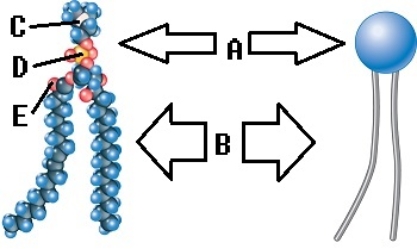A) Fatty acid A is saturated.
B) Both fatty acids are saturated.
C) Both fatty acids are unsaturated.
D) Fatty acid B is saturated.
E) Fatty acid B is unsaturated.
G) C) and E)
Correct Answer

verified
Correct Answer
verified
Multiple Choice
Electrolytes are substances that
A) are NOT found in the human body in any appreciable amounts.
B) form covalent bonds with water.
C) cannot conduct electricity in solution.
D) are NOT charged particles.
E) conduct electricity when dissolved in water.
G) None of the above
Correct Answer

verified
Correct Answer
verified
Multiple Choice
Carbon dioxide is considered a(n)
A) compound.
B) molecule.
C) ion.
D) element.
E) molecule and a compound.
G) A) and E)
Correct Answer

verified
Correct Answer
verified
Multiple Choice
The pH value
A) is determined by the concentration of hydrogen ions.
B) decreases with alkalinity.
C) is measured on a scale from 0 to 10.
D) reflects the sodium content of body fluids.
E) increases with acidity.
G) B) and C)
Correct Answer

verified
Correct Answer
verified
Multiple Choice
Phospholipids
A) are fat-soluble vitamins.
B) are found in cell membranes.
C) contain subunits called amino acids.
D) are water-soluble.
E) are a type of steroid.
G) A) and D)
Correct Answer

verified
Correct Answer
verified
Multiple Choice
Which of the following is the correct sequence from smallest to largest?
A) amino acid, cell, protein, atom
B) protein, cell, amino acid, atom
C) amino acid, atom, cell, protein
D) atom, amino acid, protein, cell
E) cell, protein, amino acid, atom
G) A) and C)
Correct Answer

verified
Correct Answer
verified
Multiple Choice
Denaturation is
A) a change in the three-dimensional structure of a protein.
B) a negatively charged ion.
C) a substance that conducts electricity when placed in solution.
D) a positively charged ion.
E) a combination of atoms held together by chemical bonds.
G) B) and C)
Correct Answer

verified
Correct Answer
verified
Multiple Choice
What type of covalent bond is formed between amino acid molecules during protein synthesis?
A) electrovalent bond
B) amino bond
C) peptide bond
D) hydrogen bond
E) primary bond
G) C) and D)
Correct Answer

verified
Correct Answer
verified
Multiple Choice
A neutral atom contains
A) more protons than electrons.
B) more electrons than protons.
C) the same number of electrons and protons.
D) only neutrons.
E) None of these choices is correct.
G) B) and E)
Correct Answer

verified
Correct Answer
verified
Multiple Choice
From the following list, select the one organic substance found in the human body.
A) water
B) glucose
C) oxygen
D) calcium
F) A) and B)
Correct Answer

verified
Correct Answer
verified
Multiple Choice
Chemical reactions with the property of being able to proceed from reactants to products and from products to reactants are called
A) synthesis reactions.
B) decomposition reactions.
C) exchange reactions.
D) reversible reactions.
E) net reaction rates.
G) A) and D)
Correct Answer

verified
Correct Answer
verified
Multiple Choice
Polysaccharides
A) are the smallest carbohydrates.
B) contain carbon, hydrogen, and phosphate atoms.
C) are not found in plants.
D) contain long chains of monosaccharides.
E) are formed when sucrose and glucose combine.
G) All of the above
Correct Answer

verified
Correct Answer
verified
Multiple Choice
The presence of water in our bodies allows us to
A) cool the body with sweat.
B) maintain a fairly constant body temperature.
C) provide an environment for chemical reactions.
D) keep tissues moist and reduce friction.
E) All of these choices are correct.
G) A) and B)
Correct Answer

verified
Correct Answer
verified
Multiple Choice
Subatomic particles located around the nucleus of an atom are
A) electrons.
B) neutrons.
C) photons.
D) protons.
E) neutrinos.
G) A) and D)
Correct Answer

verified
Correct Answer
verified
Multiple Choice
An individual hydrogen bond in a sample of water would be described as:
A) strong and intramolecular.
B) weak and intramolecular.
C) weak and intermolecular.
D) strong and intermolecular.
F) A) and B)
Correct Answer

verified
Correct Answer
verified
Multiple Choice
An enzyme
A) has a two-dimensional shape.
B) is a protein catalyst.
C) increases the activation energy needed in a chemical reaction.
D) cannot be denatured.
E) is permanently changed in a chemical reaction.
G) A) and D)
Correct Answer

verified
Correct Answer
verified
Multiple Choice
 -Phospholipids are important components of the plasma membrane. What does "C" represent on the diagram?
-Phospholipids are important components of the plasma membrane. What does "C" represent on the diagram?
A) phosphorus
B) oxygen
C) nitrogen
D) polar (hydrophilic) region
E) nonpolar (hydrophobic) region
G) A) and E)
Correct Answer

verified
Correct Answer
verified
Multiple Choice
When the hydrogen bonds that maintain a protein's three-dimensional shape are broken, the protein becomes nonfunctional, and is said to be
A) unsaturated.
B) essential.
C) saturated.
D) denatured.
E) structural.
G) A) and E)
Correct Answer

verified
Correct Answer
verified
Multiple Choice
Which of the following means a change in shape of a protein?
A) primary structure of protein
B) peptide bond
C) denaturation
D) amino acid
E) secondary structure of protein
G) A) and B)
Correct Answer

verified
Correct Answer
verified
Multiple Choice
Which of the following would be classified as a lipid?
A) catalase-an enzyme
B) alanine-an amino acid
C) starch-a polysaccharide
D) cholesterol-a steroid
E) sucrose-a disaccharide
G) B) and D)
Correct Answer

verified
Correct Answer
verified
Showing 21 - 40 of 168
Related Exams